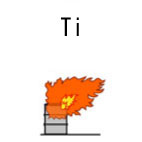| Case Name |
Fire of a high-pressure thermal gravimeter at a university |
| Pictograph |

|
| Date |
June 4, 1996 |
| Place |
Minato, Tokyo, Japan |
| Location |
University |
| Overview |
An explosion occurred at a high-pressure thermal gravimeter during an experiment under a pure oxygen atmosphere. Although the cause of the explosion has not been determined, it should have been recognized that there was a possibility of combustion of metal under pure pressurized oxygen. |
| Incident |
In the research on the yttrium superconductive system at a university, in order to confirm the thermal behavior of an YBa2Cu3O7-8 superconductor, a thermal gravimeter was used. Then a fire like an explosion occurred inside the balance, and combustion products spouted out from the wiring ejection mouth. |
| Processing |
Research and development |
| Individual Process |
Other |
| Substance |
Titanium, Fig2 |
| Oxygen, Fig3 |
| Stainless steel |
| Type of Accident |
Fire |
| Sequence |
In order to examine the reason why an YBa2Cu3O7-8 superconductor loses superconductivity due to differences in oxygen, the thermal behavior of the YBa2Cu3O7-8 superconductor was measured with a thermal gravimeter in a pure oxygen environment. By the previous day, experiments under atmospheric pressure and under pure oxygen pressure of 0.2 MPaG and 0.4 MPaG had been finished on the identical sample. The experiment on that day was carried out without changing the sample. Turned on the power supply of the equipment at about 09:00, pressurized the sample with pure oxygen to 0.9 MPaG for 30 min., waited for the sample weight to be stabilized, and started the program for heating to 90 °C at the 5 K/min. Automatic recording was stopped at the 600 °C after 107 minutes. |
| Cause |
As the heating program ran as scheduled and no rapid exothermic reaction was observed, the cause of the fire was not a runaway reaction, but some electrical problem such as a spark or a short circuit due to defects of a connection at a power cable terminal. Non-metallic material ignited, titanium burned, and the balance part burned and melted and the melting metal reacted with stainless steel. |
| Response |
The valve of the cylinder was closed, and fire extinguishing activities were carried out. |
| Countermeasures |
A structure that prevents sparks and a short circuit was chosen. Incombustible material was used for the inside of the pressure-proof container, measurement conditions were improved, and protective measures were applied for the circumference. |
| Knowledge Comment |
It is doubtful whether they recognized the hazards of an experiment with pressurized pure oxygen. |
| Background |
Not known. |
| Sequel |
The apparatus that caused the accident was delivered about four months before, adjusted two months before, and experiments had been carried out under similar conditions about 14-15 times. |
| Reason for Adding to DB |
Example of fire at a university |
| Scenario |
| Primary Scenario
|
Carelessness, Insufficient Precaution, Insufficient Inspection before Usage, Poor Value Perception, Poor Safety Awareness, Inadequate Safety Training/Education, Usage, Operation/Use, Bad Event, Electrical Failure, Mal Connection, Secondary Damage, External Damage, Fire
|
|
| Sources |
The U laboratory, New material science research division, B institute of T university, Fire accident investigation committee report.
|
| Physical Damage |
Experimental equipment, documents, chairs, etc. were destroyed by fire. |
| Multimedia Files |
Fig2.Chemical formula
|
|
Fig3.Chemical formula
|
| Field |
Chemicals and Plants
|
| Author |
ARAI, Mitsuru (Environmental Science Center, The University of Tokyo)
TAMURA, Masamitsu (Center for Risk Management and Safety Sciences, Yokohama National University)
|
|